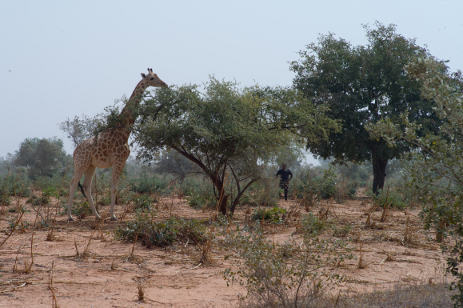Has the Niger White Giraffe escaped extinction ?
Niger’s white giraffe (Giraffa camelopardalis peralta) is a subspecies distinguished by the pale spots on its coat.
From only 50 individuals in 1996, its population has risen to 366 in 2012. Threatened by drought, by exploitation of the acacia they feed on, by the transformation of the savannah into millet fields, and by poaching, the giant of the bush was nearly wiped out.
Thanks to the action of ASGN (the Association to Safeguard the Giraffes of Niger) and to the State’s involvement, the population of Niger’s giraffes has narrowly escaped extinction.
The last self-sustaining herd of Niger giraffes lives in the South-West of Niger, in the Dosso region in Kouré. The giraffes regularly come to forage in the villages of Dankassari, over 200kms from Kouré, particularly at the harvest season of niebe beans, a favourite fodder of theirs. They then have to be guided northward, to prevent them from crossing the border to Nigeria where poaching sometimes occurs.
To save the Giraffes, one must support the local population.
Following that principle, the last of Niger’s giraffe herd benefits from a rescue program combined with a rural development program and with ecotourism activities.
Nigeriens are proud of their white giraffe. They now consider it as a national heritage
The ‘Giraffe in the Wild’ Project, from Niger to Cesson-Sévigné.
Early in 2014, Jean-Pierre Estournet and Abdoul Aziz Soumaïla photographed and filmed Kouré giraffes while reporting in Niger.
The ‘Giraffe in the Wild’Project will include several events in Cesson-Sévigné starting on May 19th 2014:
- Exhibitions : from May 26th to early July : photos of wild giraffes, exhibited in the open air, in Jean Boucher Square. From May 19th to June 6th, in the Citizen’s Hall, four panels showing the action of ASGN.
- Films: a new 10-mn film (edited by Yves Quenec’hdu) and an 8mn presentation of the action of the Doué-la-Fontaine Bioparc action in favour of Niger giraffes, both shown at the Citizen’s Hall.
- Conference: May 27th, at the Science Hall in Rennes, within the ‘Science on Tuesday’ Program. Lecturers : Pierre Gay, director of the Doué-la-Fontaine Bioparc and Jacques Rigoulet, veterinary surgeon, Botanical and Zoological Gardens Department, Natural History Museum.
- Events: on May 27th, in Cesson, Pierre Gay will explain how giraffes are identified thanks to their spots.
- A competition for school children: based on a quiz, with wood or brass giraffes as prizes for the best answers.
Partners : Town of Cesson-Sévigné, AESCD, Science Hall, Doué-la-Fontaine Bioparc, ASGN.


